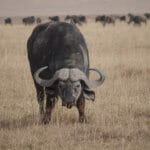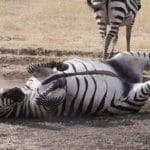Standing in camp looking out over the crater rim as the sun slowly rose I could hardly believe I was here. Ever since I had seen the Ngorongoro Crater on a nature documentary in the late 80’s as a child I had held a fascination for Africa.
But beyond what I had seen in safari documentaries, the Ngorongoro Crater remained a mystery, not just to me but to everyone in our group.
Formed 2 – 3 million years ago years ago by a huge volcano that exploded and then collapsed leaving the worlds largest unbroken and non flooded volcanic caldera. It’s estimated that the original volcano could have been almost as high as neighbouring Kilimanjaro.
Six hundred meters deep, views from the various observation platforms, camps and hotels 2000 feet up on the crater rim are as spectacular as you would imagine. The crater floor is a mind numbing 20 kilometres in diameter and 260 square kilometres in area. Everything about the crater is huge.

The breathtaking view from the viewing platform with the dried up Magadi Salt Lake towards the top left.
The entire Ngorongoro Conservation Area covers 8292 square kilometres in the Arusha region of north west Tanzania. While the Serengeti Plains and neighbouring Ngorongoro Crater are probably the best know areas within that, the conversation area also encompasses the Oldupai Gorge.
A trail of footprints from our earliest relatives, the hominids, have been found preserved in volcanic ash in nearby Laetoli. The discovery proved that the earliest humans walked upright on 2 feet (bipedal) 3.6 millions years ago, a full million years before the invention of stone tools.
Our early ancestors have co-existed with the local wildlife in the Ngrongoro Crater and Serengeti Plains for nearly 4 million years. Today the entire conservation area is both a World Heritage Site and an International Biosphere Reserve. Along with the Crater and the sprawling plains you will also find 2 more craters (Olmoti and Empakai) and the Northern Highland Forest Reserve.
The wildlife is as varied as the landscape. Within the steep crater walls the grasslands supports giant herds of zebra, wildebeest and buffalo along with Grant’s and Thompson’s gazelle. In fact the crater is large enough to support 25,000 large animals including 26 Black Rhinos, the densest known population of lions currently numbering 62, along with 7,000 wildebeest, 4,000 zebra and 3,000 Grant’s and Thompson’s gazelle while the rainforest on the crater walls support a healthy population of elephant, spotted hyenas, jackals, cheetahs and wild dogs.
All this prey supports a healthy population of predators. Ngorongoro is the best place in Africa to see “The Big Five”, a collection of animals known to be the hardest to track on foot in the 19th Century; African Lion, African elephant, Cape buffalo, Rhinoceros & African Leopard. Today we tend to shoot with cameras and not guns but that doesn’t mean that finding the more camera shy animals such as leopards will be any less of a challenge even in what is effectively a giant bowl.

The critically endangered black rhinoceros. Your best chance of seeing them is in the protected confines of the Ngorongoro Crater.
Although the crater rim forms a natural barrier, the animals that call the crater their home choose not to leave. The conditions on the crater floor are that good.
While the animals are allowed to stay in the park at night, humans are not and must be out by sunset. Not even the Masai, who once called this place home, are allowed to stay in the crater with their grazing cattle past sunset. A small selection of campsites and boutique hotels have sprung up around the crater rim to fill the need for overnight lodging.
Standing in the middle of camp looking out towards the crater, the sky had turned the deepest shade of red I had ever seen. The full scale of the crater was hidden by dense woodland that, thanks to some seriously poisonous critters, was off limits to us to explore further but the crater is so big it creates its own microclimate, and as the sun got lower, the clouds started flowing over the rim. Everyone in camp stopped what they were doing and came to look at the spectacle.
The crater floor is mainly grassland with a couple of small wooded areas of fever trees while, in the centre of the crater there is a seasonal salt lake called Magadi which is fed by the main water source for all the animals, the Munge Stream. Near the eastern wall there is the Ngoitokitok Spring, another popular water source as well as serving as a picturesque picnic spot for the gathering tourists. You may be able to spot wallowing hippos in the connected swamp. Don’t go wandering too far; lions are also known to frequent the area!
From the first moment we laid eyes on the Ngorongoro Crater at the observation deck days earlier on our way through to the Serengeti we were captivated.. We wouldn’t realise until our return that the Ngorongoro Crater would more than live up to it’s reputation as Africa’s number one park to spot the “Big 5”.

The Ngoitokitok Spring near the eastern wall of the crater is another important source of water and one of only 2 places in the caldera you are allowed to walk around.
Standing silent in our van, what we were seeing unfolding before us felt like it should be on a prime time BBC documentary with David Attenborough narrating.
A young pride of lionesses were attempting to take down a buffalo. They were all young, still learning their craft. The matriarch was putting her life on the line so they could eat but the buffalo wasn’t going down without a fight. What ensued was the longest, most painful 40 minutes of real life I have witnessed.
As the action started to unfold we were all routing for the lionesses. After all, this is what we had come to see but as the seconds ticked by everyone wanted the buffalo to pull through. To find a way out through insurmountable odds. Ultimately he gave up his life so that the lionesses could live and we had been witness to 2 of the “Big 5” going toe to toe only with no editing or slick camera work. It was brutal watching the buffalo getting eaten alive but ultimately this is the circle of life without the Disney pixie dust.
What we had just seen, however uncomfortable, is really what the Ngorongoro Crater is all about. There are no camera filters here. Venture into the crater and you will see real life all around you. Life and death in the crater is sometimes uncomfortable viewing but I wouldn’t want it any other way.
 Copyright secured by Digiprove © 2017
Copyright secured by Digiprove © 2017












